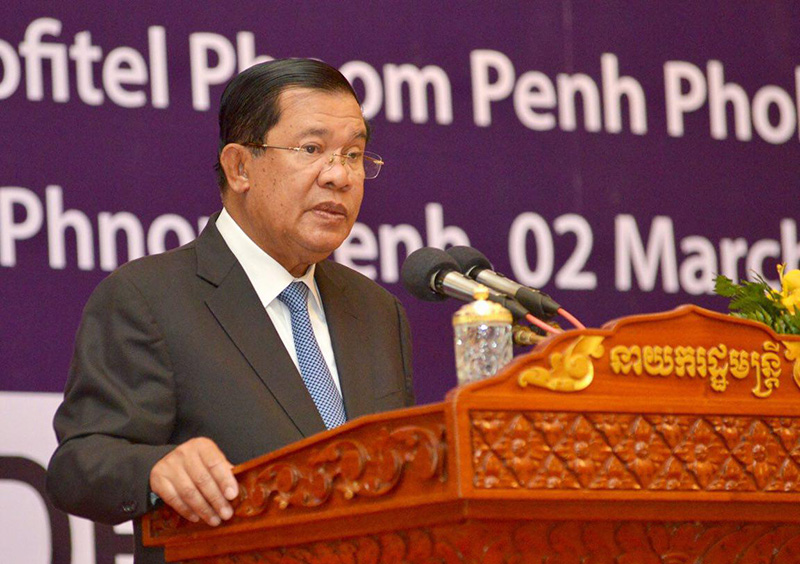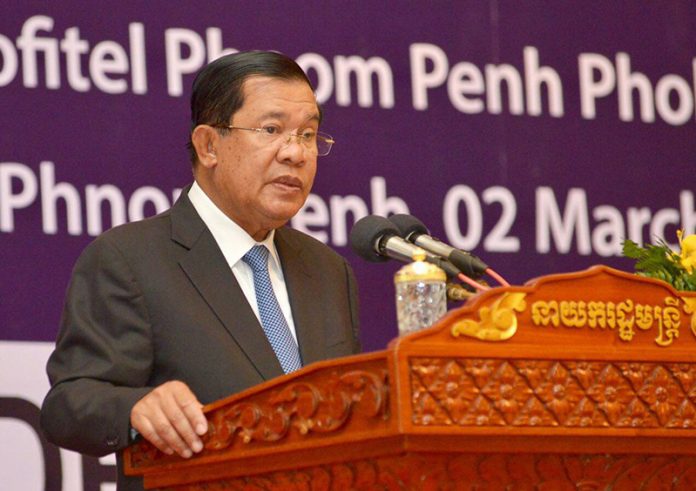[Unofficial Translation]
CNV: 02/03/2017
Excellencies, distinguished guests, ladies and gentlemen!
Today it is my great pleasure to participate in the 2017 Cambodia Outlook Conference under the topic “Moving up the Value Chain of Industrialization, Growth and Digital Development”. This is the eleventh time that I have participated and delivered keynote address in this important annual conference. Once again, I wish to express my high appreciation to the Cambodia Development Resource Institute (CDRI) and ANZ Royal for continuing this initiative and inviting senior officials of the Royal Government of Cambodia, representative of private sector, academia, NGOs and development partners to come together to review Cambodia’s achievements and challenges to date as well as to figure out how we can work together to achieve our development goal and the national interest.
Normally, I always take this opportunity to share Cambodia economic development and outlook for the current and next year. Overall, from 2004 to the present, Cambodia experienced economic growth as expected. Our economic growth reached around 7% per annum in the last three years. Economic growth in 2014 and 2015 was underpinned by construction and real estate while slower performance in agriculture caused by climate change and low agricultural product prices. In 2016, Cambodia achieved economic growth of around 7.1%, thanks to the recovery of agriculture and better performance of non-garment industry while the growth of construction, garment and real estate slowed down due to tightening of lending in banking sector and changes in trade regime and regional context.
At the same time, it is undeniable that achieving sustainable growth at 7% stems from the implementation of the right economic and business policies, especially the result of nationwide peace and political stability that the Government is determined to uphold both in the present and the future.
Based on the projection, Cambodia’s economy will grow by 7% in 2017, thanks to expected recovery of agriculture and garment compared to 2016 while construction and real estate sector are expected to experience slower growth due to adjustments of credit and oversupply situation. Besides, non-garment industries are expected to perform well to underpin overall economic performance. This situation is expected to extend until 2018 for which growth is expected to achieve around 7%.
However, Cambodia’s economy also face some external risks such as the uncertainty of potential rate hike by US Federal Reserve, Brexit and the future of EU, risk of China’s hard landing and slower growth of some emerging economies, trade tension between China and the new US administration as well as other rising geopolitical tensions. In addition, the expectation for the recovery of oil and international commodities price is also a risk for Cambodia economy. All these signal the need and urgency to reform and diversify our economic structure aiming for higher value-added sector in order to maintain sustainable growth in the medium and long term.
In this spirit, we need to further strive to achieve economic growth of 7% to realize our ambition to become an upper-middle income country by 2030 and higher income country by 2050. To achieve this, we must step up the implementation of Industrial Development Policy (IDP) 2015-2025 adopted by the Royal Government and regard it as “New Growth Strategy,” which guides industrial development, economic diversification and enhancement of competitiveness and productivity in Cambodia in order to move up in the regional and global value chain. Overall, Cambodia has to modernize its industrial sector since it will be instrumental to the new growth strategy, a catalyst supporting medium and long term growth, a sector with great potential for additional job creation for youth, and a buttress for economic growth in order to attract further investments in addition to agriculture and tourism sectors.
Excellencies, Ladies and Gentlemen,
The topic of our conference today is very timely for Cambodia, particularly industrialization and our growth vision and sustainable development. In this respect, Cambodia must strive to diversify its economic growth base on proactive basis, especially integrate its manufacturing sector into higher global value chain. Indeed, global value chain is an important part of the global trading system since it allows international leading companies’ access to cheaper, diversified and quality inputs, in short this contributes to the enhancement of efficiency and competitiveness. For instance, the advanced countries such as Japan and Korea produce only assembly parts and export them to countries like China, Thailand, Vietnam and Cambodia for assembly to become final products for export.
In addition, more evidences support high positive correlation between active participation in the global value chain and some economic indicators such as productivity, export success, employment and economic growth. In this sense, participation in the global value chains can help attract foreign direct investment, stimulate private sector development and job creation. For instance, BRICS member countries such as Brazil, Russia, India, China, and South Africa and newly industrial countries in East Asia are all linked to successful participation in the global value chain. Likewise, the success of Cambodia’s textile and footwear sectors is an example of successful participation in the global value chain.
Along with this, we have seen rapid industrial development in Cambodia. The industry sector accounted for 28.9% in 2016 compared to 13.5% in 1994. It is undeniable that peace, political stability and successful shift towards the market economy that encourage investment, trade and private sector development really plays key roles in the socio-economic development to date. This favorable condition enables Cambodia to attain GVC participation index of 49%, a bit lower than Vietnam and the Philippines. In ASEAN, Singapore, Malaysia, and Thailand have the highest GVC participation index. In particular, most of Cambodia’s GVC participation is textile and footwear industries while participation of industries such as electronics, equipment and automobile is gradually increasing.
This result is an important basis for further industrial diversification and modernization. In addition, regional economic structure is moving toward deeper integration and better connectivity. GMS region is now more integrated and ASEAN has achieved great success in deepening its integration of ASEAN economic community. At the same time, the world economic power China has launched “one belt, one road” initiative and other financing mechanisms such as Asia Infrastructure Investment Bank (AIIB) and Silk Road Fund which could help boost the development of Cambodia and the region. Another emerging trend shows that companies from Japan, USA, EU, South Korea, Australia and China are searching for cheaper and more efficient production base.
While maintaining full peace, political stability, macroeconomic stability and social order, Cambodia has paid great attention to developing vibrant connectivity infrastructure that connect rural areas with urban areas, especially special economic zones as well as with countries participating in the regional value chain, creation of a regulatory system that allows for smooth business operation, implementation of open trade and investment policy, protection of intellectual property right, and development skilled workers and human resources. This is a new opportunity for Cambodia’s industrial diversification and modernization in the global value chain. For instance, the presence of Denso, Yazaji, Nippon Express, Minebea Mitsumi from Japan and Xuaxin Cement from China in Cambodia shows we are moving in the right direction to a new level of industrialization.
In addition, Cambodia Industrial Development Policy 2015-2025 would help modernize our industry and help us move form labor-intensive industry to a skill-driven industry through connecting to regional and global value chain, developing interconnected production clusters along with effort to strengthen competitiveness and enhance productivity and diversify domestic industries. We are well aware that in order to realize the transformation and modernization of its industrial structure, various policies must be aligned and the industrial development policy must be linked to other sectoral policies such as trade, investment, education, transport, logistics, science and technologies etc. To move up in the global value chain and to stimulate industrialization to promote growth and development, I request relevant ministries-institutions, private sector, development partners, research groups and educational organization to work closely together on permanent basis.
Once again, I congratulate you all on the organization of this annual conference which would encourage exchange of views and constructive dialogue from stakeholders and interest group. I believe today’s conference which is held under the theme of “moving up the global value chain of industrialization, growth and digital development” will come up with recommendations to help us accelerate socio-economic development.
Finally, I wish Excellencies, distinguished guests, ladies and gentlemen happiness, prosperity and success in all endeavors.
Thank you.



![Selected Comments of Samdech Techo HUN SEN. at the inauguration of Techo Santepheap coastal highway – Angkol Beach, under a concessional loan from the Asian Development Bank [Selected Translations]](https://pressocm.gov.kh/wp-content/uploads/2024/11/photo_2024-11-11_11-06-30-324x235.jpg)

![Selected Comments of Samdech Techo HUN SEN. on Facebook: “Why do we call on the CNRP Commune/Sangkat Councilors to join the CPP?” [Unofficial Translation]](https://pressocm.gov.kh/wp-content/uploads/2024/07/SD-Hun-Sen-100x70.jpg)

